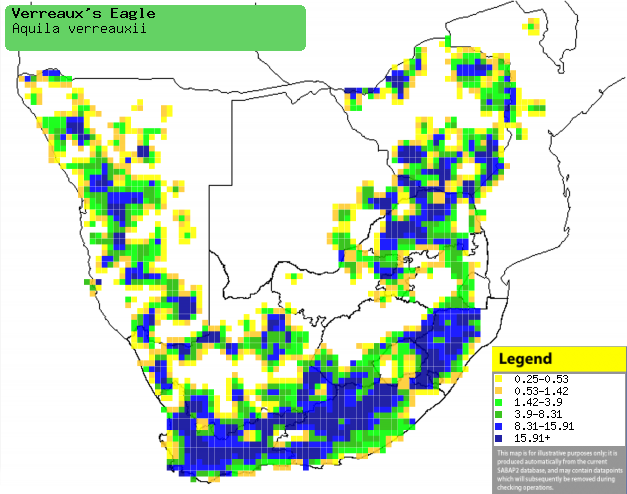|
Aquila verreauxii (Verreauxs'
eagle, Black eagle)
Witkruisarend [Afrikaans]; Ukhozi (generic term for eagle),
Untsho [Xhosa]; uKhozi (generic term for eagle) [Zulu]; Ngongo zonsavagani
[Kwangali]; Mojalipela, Moja-lipela, Seoli, Ntsu [South Sotho]; Rovambira
[Shona]; Ghama (generic term for eagle) [Tsonga]; Ntsu, Ntswi (generic
terms for eagles) [Tswana]; Zwarte arend [Dutch]; Aigle de Verreaux
[French]; Felsenadler, Kaffernadler [German]; Įguia-preta [Portuguese]
Life
> Eukaryotes >
Opisthokonta
> Metazoa (animals) >
Bilateria >
Deuterostomia > Chordata >
Craniata > Vertebrata (vertebrates) > Gnathostomata (jawed
vertebrates) > Teleostomi (teleost fish) > Osteichthyes (bony fish) > Class:
Sarcopterygii (lobe-finned
fish) > Stegocephalia (terrestrial
vertebrates) > Tetrapoda
(four-legged vertebrates) > Reptiliomorpha > Amniota >
Reptilia (reptiles) >
Romeriida > Diapsida > Archosauromorpha > Archosauria >
Dinosauria
(dinosaurs) > Saurischia > Theropoda (bipedal predatory dinosaurs) >
Coelurosauria > Maniraptora > Aves
(birds) > Order: Falconiformes
> Family: Accipitridae
> Genus: Aquila
Distribution and habitat
It's distribution is strongly linked to that of the
rock
hyraxes, occurring from Eritrea through Ethiopia, Kenya, Tanzania and Zambia
to South Africa. In southern Africa, it is locally fairly common in Zimbabwe, Namibia and
South Africa, marginally extending into eastern Botswana and western Mozambique.
It
generally prefers mountains and other rocky habitats with cliffs.
|
 |
|
Distribution of Verreaux's eagle in southern Africa,
based on statistical smoothing of the records from first SA Bird Atlas
Project (©
Animal Demography unit, University of
Cape Town; smoothing by Birgit Erni and Francesca Little). Colours range
from dark blue (most common) through to yellow (least common).
See here for the latest distribution
from the SABAP2. |
Predators and parasites
The chicks are prey of the following animals
Movements and migrations
Adults are resident, but juveniles and immature
birds are nomadic.
Food
It mainly eats mammals, especially
rock
hyraxes, doing most of its hunting from a perch, from which it descends to
pluck prey from the ground. It often hunts in pairs, so that one bird can flush
prey by skimming the rockface, while the other follows to strike; they share the
meat afterwards. It tends to hunt
rock
hyraxes in the early morning and evening, when they take up exposed positions
to warm up; it sometimes surprises the hyraxes to such an extent that they fall down the rockface to their
deaths. The following food items have been recorded
in its diet:
Breeding
- Monogamous, territorial solitary nester, alternating between up to five
different nest sites from one breeding season to the next, although it often
favours one of them and uses it for many years.
- The nest (see image below) is built by both sexes in six weeks to four
months, consisting of a large platform of sticks with a cup lined with green
leaves. It is typically placed on a steep and inaccessible cliff, although
it may also use a tree, such as Mountain-acacia (Brachystegia glaucescens),
Euporbia, Baobab (Adansonia digitata) or Stone pine (Pinus
pinea). It rarely uses a man-made structure, or it can even take over
the nest of another bird, such as the
African fish-eagle, instead of building its own.
- Egg-laying season is from April-July, peaking in June.
- It lays 1-2 eggs, which are mainly incubated by the female for about
44-48 days, while the male feeds her at the nest.
- The chicks are fed by the female with food provided by the male, and can
already feed themselves at four weeks. If there are two chicks, the older one
relentlessly attacks its younger sibling until it dies, regardless of the
fact that they are both cared for and fed equally. The surviving chick
leaves the nest at about 90-98 days old, and is chased out of the territory
by its parents about four months later.
Threats
Not threatened globally, with a remarkably stable population
in southern Africa, although it is Near-threatened in Namibia due to its small
population there.
References
-
Hockey PAR, Dean WRJ and Ryan PG 2005. Roberts
- Birds of southern Africa, VIIth ed. The Trustees of the John Voelcker
Bird Book Fund, Cape Town.
|
